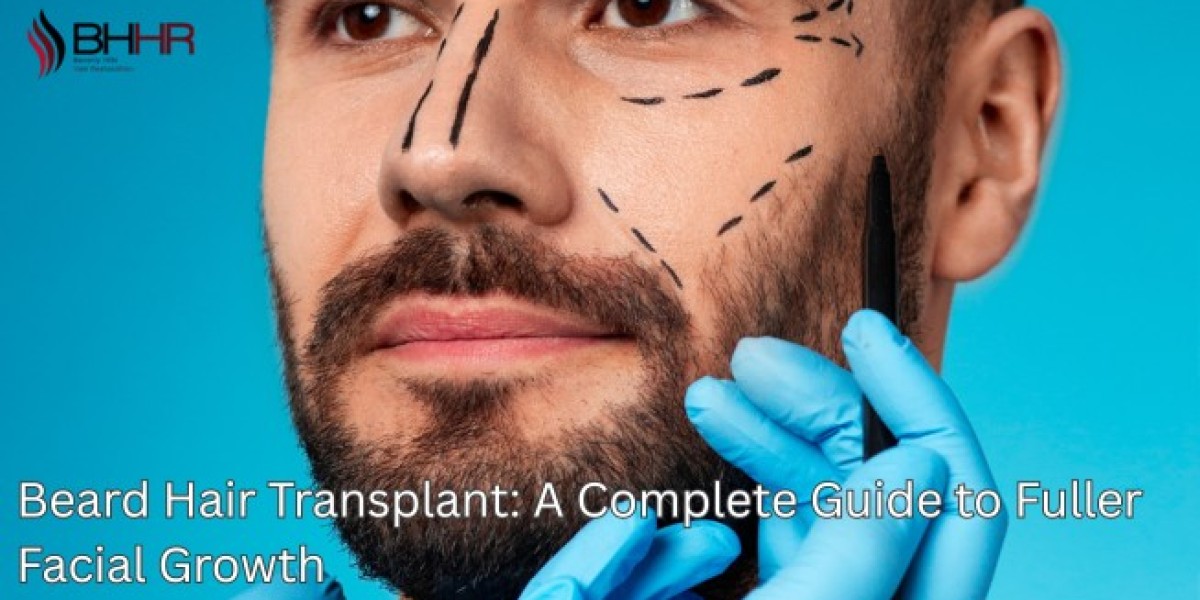Facial hair has become a strong symbol of confidence, style, and maturity in recent years. Social influence, grooming trends, and personal preference have encouraged men to aim for thicker, well-defined facial hair. However, not everyone can grow a full beard naturally. Patchy growth can occur due to hormonal imbalance, genetics, scarring, or medical conditions. When traditional beard-enhancing products fail, many individuals turn to long-term medical solutions such as a beard hair transplant. This procedure offers consistent and natural-looking results, making it a popular choice worldwide.
What Is a Beard Hair Transplant?
It is a minimally invasive surgical technique in which healthy hair follicles are harvested from the donor area—typically the back of the scalp—and implanted into areas on the face where growth is thin or missing. These implanted follicles behave like natural beard hair once they start growing. Patients can trim, shave, and style them without restrictions. The goal is not just to increase density, but to redesign facial contours, improve symmetry, and provide a fuller aesthetic.
Why Do Some Men Struggle to Grow Facial Hair?
Patchy or thin beard growth may be caused by several factors:
Genetics: The most common reason for uneven facial hair.
Hormones: Imbalance in testosterone or dihydrotestosterone levels.
Scarred Skin: Burns, injuries, or acne scars may block follicular growth.
Medical History: Conditions like alopecia areata eliminate hair follicles.
Unlike temporary cosmetic solutions, this treatment provides a permanent and natural enhancement.
Who Is a Good Candidate?
Healthy male adults who have sufficient donor hair from the scalp are typically suitable candidates. Ideal patients also:
Want to correct patchy areas
Desire a thicker or full beard design
Have realistic expectations
Are non-smokers or willing to reduce smoking before surgery
A specialist consultation ensures eligibility and clarifies achievable results.
Techniques Used in the Procedure
Two main techniques are practiced:
Follicular Unit Extraction (FUE)
A modern technique where individual follicles are removed using micro-punch tools. It offers several advantages:
Minimal scarring
Faster recovery
Precise graft placement
It is currently the most preferred option due to natural outcomes and comfort.
Follicular Unit Transplantation (FUT)
A small strip of skin containing multiple follicles is removed from the donor area. Although this method may leave a linear scar, it provides a large quantity of grafts in a single session. Patients with significant baldness or patchiness may benefit from this strategy.
Step-By-Step Process
Consultation: A surgeon evaluates beard design, donor area, and expected density.
Design Mapping: The doctor outlines the beard shape to match facial symmetry.
Local Anesthesia: Ensures the patient feels no pain during the procedure.
Harvesting: Donor follicles are collected using FUE or FUT.
Implantation: Tiny incisions are created following natural growth angles.
Completion: The beard looks more defined immediately, though growth begins gradually.
Surgeons focus on angle, direction, and spacing to ensure realistic results.
Recovery Timeline
Recovery is generally smooth and comfortable:
Mild redness and swelling disappear within a few days.
Scabbing naturally falls off in one to two weeks.
Patients can return to work almost immediately.
New hair begins to grow within three to four months.
Full results are visible around eight to twelve months.
Temporary shedding of transplanted hair can occur early on—this is normal and part of the growth cycle.
Aftercare Instructions
Proper aftercare improves outcomes. Specialists may advise:
Avoid touching or scratching the transplanted area.
Sleep with your head elevated for the first few nights.
Refrain from heavy workouts for at least one week.
Do not shave until advised.
Avoid exposure to direct sunlight for a short period.
Following these guidelines ensures follicles settle securely.
Potential Risks and Side Effects
While the procedure is safe, minor effects may include:
Redness
Slight swelling
Itching
Temporary numbness
These usually fade without intervention. When performed by an experienced surgeon, serious risks are extremely rare.
How Much Does a Procedure Cost?
Pricing varies depending on:
Clinic location and reputation
Number of grafts required
Surgeon experience
Procedure complexity
Although the cost may feel high initially, the long-term value makes it a worthwhile investment for many patients seeking permanent improvement.
Results You Can Expect
Patients often notice:
Improved beard shape
Enhanced facial symmetry
Natural-looking density
Increased styling freedom
Unlike artificial alternatives, transplanted follicles blend seamlessly with original hair.
Confidence, self-esteem, and personal satisfaction are frequently reported benefits after completion.
Choosing the Right Surgeon
Selecting a qualified specialist is the most important factor in achieving high-quality results. Consider the following:
Years of experience
Availability of before-and-after examples
Transparent explanations during consultation
Positive patient reviews
Sterile, certified clinic environment
A skilled surgeon considers facial structure, growth direction, and aesthetics while planning treatment.
Long-Term Maintenance
One major advantage is that transplanted hair follows the characteristics of normal beard hair. Once fully grown, maintenance is simple:
Regular washing
Conditioning as needed
Trimming and styling to preference
No special products or treatments are required beyond basic grooming.
Why This Solution Is Growing in Popularity
Modern grooming standards and social influence have increased the demand for permanent facial hair solutions. Professionals in acting, media, modeling, and brand representation often prioritize a fuller beard for improved appearance. Additionally, psychological benefits encourage many men to pursue this long-term enhancement.
Final Thoughts
A beard hair transplant is an effective and permanent solution for individuals struggling with thin, patchy, or uneven beard growth. With advancements in medical technology, the results appear natural, dense, and aesthetically pleasing. Proper consultation, experienced surgeons, and attentive aftercare are essential for a successful outcome. For those looking to improve facial symmetry and confidence, this treatment stands out as one of the most reliable options available today.







